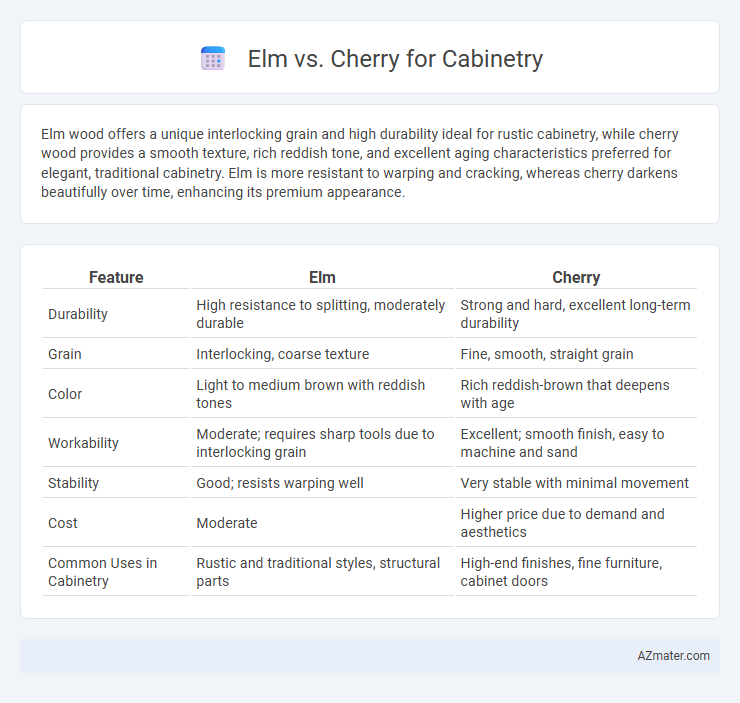Elm wood offers a unique interlocking grain and high durability ideal for rustic cabinetry, while cherry wood provides a smooth texture, rich reddish tone, and excellent aging characteristics preferred for elegant, traditional cabinetry. Elm is more resistant to warping and cracking, whereas cherry darkens beautifully over time, enhancing its premium appearance.
Table of Comparison
| Feature | Elm | Cherry |
|---|---|---|
| Durability | High resistance to splitting, moderately durable | Strong and hard, excellent long-term durability |
| Grain | Interlocking, coarse texture | Fine, smooth, straight grain |
| Color | Light to medium brown with reddish tones | Rich reddish-brown that deepens with age |
| Workability | Moderate; requires sharp tools due to interlocking grain | Excellent; smooth finish, easy to machine and sand |
| Stability | Good; resists warping well | Very stable with minimal movement |
| Cost | Moderate | Higher price due to demand and aesthetics |
| Common Uses in Cabinetry | Rustic and traditional styles, structural parts | High-end finishes, fine furniture, cabinet doors |
Introduction to Elm and Cherry Wood
Elm wood, known for its interlocking grain and durability, offers excellent resistance to splitting, making it ideal for cabinetry that requires strength and longevity. Cherry wood, prized for its smooth texture and rich, reddish-brown hue, darkens gracefully over time, providing a warm and elegant appearance in fine furniture and cabinetry. Both hardwoods balance aesthetic appeal and functional properties, with elm excelling in toughness and cherry favored for its refined finish.
Appearance and Grain Patterns
Elm wood features a distinctive interlocking grain pattern with rich, warm tones ranging from light to medium brown, often displaying striking cathedrals and swirling grain that adds character to cabinetry. Cherry wood offers a smoother, finer grain with a consistent reddish-brown hue that deepens to a rich patina over time, providing a sleek and elegant appearance ideal for classic or formal cabinetry styles. Both woods enhance cabinet aesthetics uniquely, with elm emphasizing rustic, textured looks and cherry lending a polished, sophisticated finish.
Durability and Hardness
Elm wood offers excellent durability and moderate hardness, making it resistant to wear and impact, ideal for robust cabinetry. Cherry wood is harder and denser than elm, providing superior strength and a smooth finish that withstands prolonged use. Both hardwoods resist warping, but cherry's increased hardness ensures better resistance to dents and scratches over time.
Workability and Machinability
Elm offers excellent workability with its interlocking grain that resists splitting, making it ideal for cabinet components requiring strength and durability. Cherry provides superior machinability due to its fine, uniform texture and consistent density, allowing for smooth cutting and shaping with high precision. Both woods excel in cabinetry, but elm's robustness suits structural parts, while cherry's ease of machining benefits detailed joinery and finishes.
Cost Comparison: Elm vs Cherry
Elm wood is generally more affordable than cherry, making it a cost-effective choice for cabinetry without sacrificing durability. Cherry, known for its rich color and fine grain, tends to command higher prices due to its premium aesthetic and slower growth rate. Budget-conscious projects often prefer elm for cabinetry to achieve strength and visual appeal at a lower cost compared to cherry.
Sustainability and Environmental Impact
Elm wood offers excellent sustainability credentials due to its rapid growth rate and widespread availability, making it a renewable choice for cabinetry. Cherry wood, while prized for its rich color and durability, grows slower and is often harvested from older trees, raising concerns about long-term environmental impact. Choosing elm over cherry supports reduced deforestation and promotes eco-friendly woodworking practices in cabinetry production.
Finishing and Staining Qualities
Elm offers a coarse grain with natural variance, absorbing stains unevenly which creates a rustic and textured finish ideal for traditional cabinetry styles. Cherry wood has a fine, smooth grain that accepts stains uniformly, allowing for a sleek, polished appearance often preferred in modern or formal cabinetry. Both woods respond well to finishes, but Cherry's consistent staining qualities provide greater control for achieving rich, deep hues, whereas Elm highlights a more organic, varied color palette.
Best Uses in Cabinetry
Elm wood is prized for its interlocking grain, providing excellent resistance to splitting, making it ideal for cabinet frames and structural components that require durability. Cherry wood offers a smooth texture and rich, warm color that deepens over time, making it perfect for visible cabinet doors and decorative panels where aesthetic appeal is paramount. Incorporating elm in load-bearing parts combined with cherry for surfaces ensures both strength and elegance in cabinetry design.
Maintenance and Longevity
Elm cabinetry offers superior durability and resistance to warping due to its interlocking grain structure, making it easier to maintain over time with minimal refinishing. Cherry wood, prized for its rich color and smooth texture, darkens gracefully but requires more care to prevent scratches and dents, thus needing regular polishing to maintain its appearance. Both woods provide long-lasting cabinetry solutions, but elm's resilience makes it a preferred choice for low-maintenance environments aiming for lasting integrity.
Final Verdict: Choosing the Right Wood for Cabinets
Elm offers a distinctive grain pattern and excellent durability, making it ideal for rustic or traditional cabinetry that requires strength and natural warmth. Cherry wood is prized for its smooth texture, rich reddish-brown color, and ability to darken gracefully over time, perfect for elegant, high-end cabinetry with a refined appearance. The final decision hinges on desired aesthetics and usage, with elm suited for robust, rustic designs and cherry best for sophisticated, timeless cabinetry.

Infographic: Elm vs Cherry for Cabinetry
 azmater.com
azmater.com